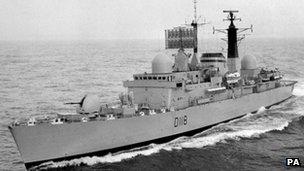HMS Coventry diver searched wreckage after ship sank
- Published

HMS Coventry was a Type 42 destroyer that was in service for less than four years
A naval diver who searched the wreck of HMS Coventry after it was sunk during the Falklands has described how he was told to ensure secret information from the ship did not get into the wrong hands.
Nineteen sailors were killed and a further 30 injured when the Type 42 destroyer took a direct hit during the Falklands War on 25 May 1982.
As the ship sank in just 20 minutes, it took with it many documents and equipment which were of "importance to the security of the United Kingdom", said Clive Gale.
He was part of a 39-strong Royal Navy team which carried out a number of dives on sunken ships, including HMS Coventry, over a four-month period beginning in the autumn of 1982.
Recalling the HMS Coventry search, he said: "We were very conscious that we were diving on a war grave and the casualties that went down with the ship.
"We actually visited their grave and that stays with you."
Carrying out Operation Blackleg was a physically demanding and dangerous mission for those involved, with some dives lasting for up to eight hours.
Some 39 divers took part in the four-month mission in the Atlantic
"We were 8,000 miles from any kind of rescue facility," Mr Gale added.
"There was still hostilities with Argentina and to cap it all there was a 500lb (227kg) unexploded bomb in the wreck somewhere.
"The whole mission was fraught with near misses.
"Cutting into a steel structure underwater traps oxygen and if you hit it with a spark it explodes quite violently.
"One chap lost the front plate out of his helmet and nearly drowned.
"I was knocked unconscious and had to be pulled back into the bell by a colleague of mine."
Mr Gale admits the mission, 300ft (91m) under the ocean's surface, was to "recover or destroy certain items".
But some things brought back from HMS Coventry, like the cross of nails, were not on the official list.
"I took off the big brass plaque while somebody else recovered the bell and the cross of nails was found," he continued.
"All these things that were really personal to the ship's company were then presented to Coventry Cathedral after we'd finished the job."
- Published25 May 2012
- Published21 May 2011